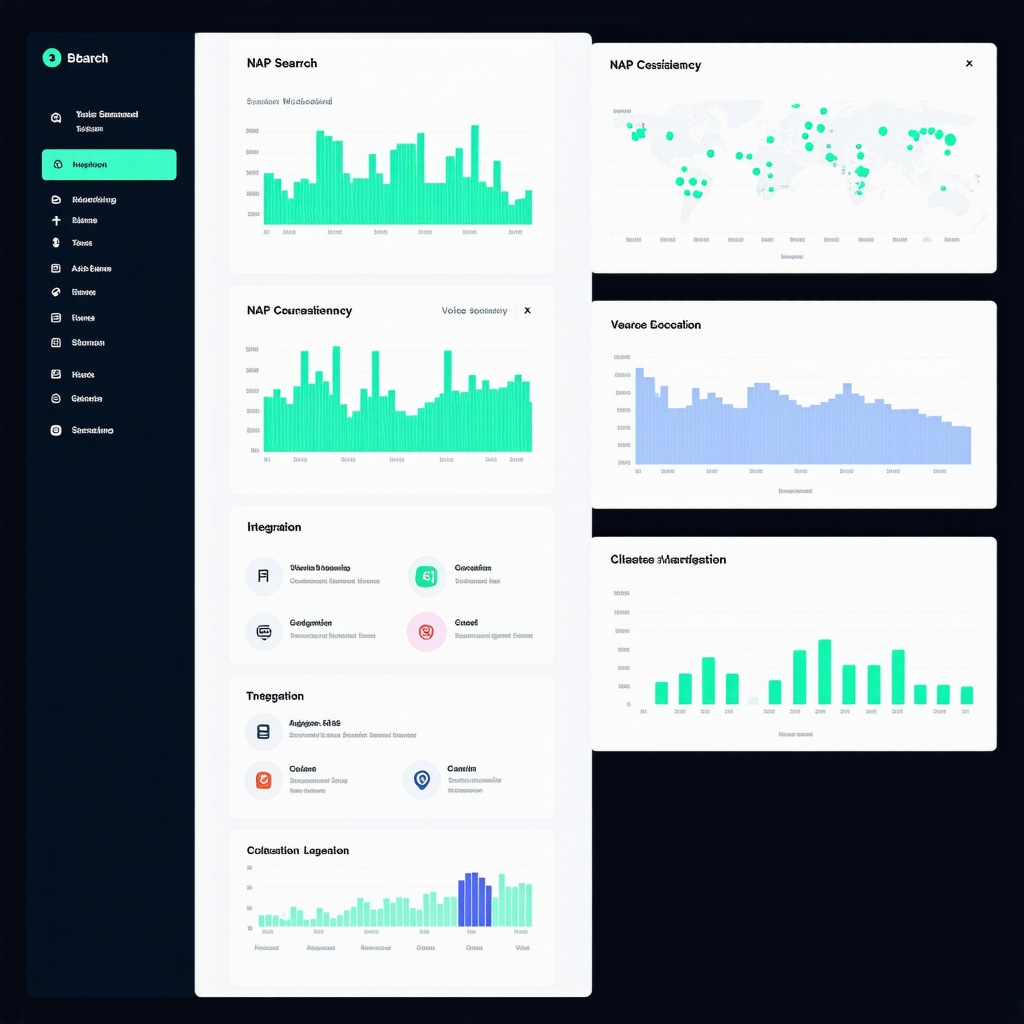When Was the Last Time You Checked Your Business’s Digital Address?
Picture this: You’re hunting for a nearby coffee shop, and every directory you check lists a slightly different phone number or address for the same place. Frustrating, right? This inconsistency isn’t just an annoyance for customers; it’s a silent killer for your local SEO efforts. Enter the world of NAP citation consistency — the triad of Name, Address, and Phone number that can make or break your local search rankings.
Why Does NAP Consistency Feel Like a Game of Whack-a-Mole?
Businesses often struggle to keep their NAP citations uniform across the web. Perhaps you’ve updated your phone number recently, but some directories stubbornly cling to the old digits. Or maybe a slight variation in your business name sneaks in, like “Bob’s Cafe” versus “Bob’s Café.” These little discrepancies create confusion not just for potential customers but also for search engines trying to verify your business legitimacy.
Could a Simple Typo Really Sink Your Local SEO Ship?
Absolutely. Search engines like Google use NAP information as a trust signal to confirm your business’s existence and location. Inconsistent citations can lead to lower rankings or even exclusion from local packs — that coveted box of businesses you see atop local search results. Moz’s study on local SEO citations highlights that consistent NAP data significantly correlates with higher local search rankings.
So, How Do You Keep Your NAP in Check Without Losing Your Mind?
First, audit your existing citations. Tools like Moz Local or BrightLocal can scan the web for your business listings and spot inconsistencies. Then, claim and update your profiles on major directories such as Yelp, Yellow Pages, and, of course, your Google Business Listing. Remember, the devil is in the details: ensure your business name, address format, and phone number are identical everywhere.
Is Automation the Magic Bullet or Just Another Complexity?
Automation tools can be a blessing, managing multiple citations from a single dashboard. However, they’re not set-and-forget solutions. Regular monitoring and manual tweaks remain crucial. For those looking to skip the headache, expert GMB citation services offer tailored management to keep your NAP pristine and your rankings climbing.
Want to Take Your Local SEO Game Seriously?
Consistency in your NAP citations isn’t a tedious chore — it’s the foundation of trust and visibility in your community. So, what are you waiting for? Dive into your listings, fix those discrepancies, and watch your local SEO thrive. Got a story about a citation mix-up or a tip that saved your rankings? Share your experience in the comments below — let’s keep the conversation buzzing!
Exploring the Nuances of NAP Citation Consistency for Local Dominance
Maintaining NAP consistency is often seen as a foundational step in local SEO, but the real challenge lies in understanding the subtle variations that can impact your rankings. For instance, consider address formatting: abbreviations like “St.” versus “Street” or including suite numbers inconsistently can confuse search engines. Similarly, phone number formats should be uniform, whether using international codes or local dialing styles. These minute details, when overlooked, create fragmented signals that diminish your local authority.
How Can Businesses Strategically Leverage NAP Consistency to Outrank Competitors in 2025?
In an increasingly competitive local SEO landscape, merely having consistent NAP data isn’t enough. Businesses must proactively update citations across emerging platforms and niche directories relevant to their industry. For example, a healthcare provider should ensure citations on health-specific directories, while a restaurant owner must prioritize food and travel sites. Additionally, integrating NAP data into social profiles and local content marketing efforts amplifies trust signals. Employing citation management services, like those detailed in expert GMB citation services, ensures comprehensive coverage and real-time updates, crucial for maintaining competitive advantage.
Moreover, monitoring user-generated content such as reviews and Q&A sections for NAP mentions can uncover hidden inconsistencies. Responding to these promptly reinforces your authoritative presence. The interplay between NAP accuracy and engagement metrics creates a robust ecosystem that search engines reward with higher visibility.
Beyond the Basics: The Role of Structured Data in Enhancing NAP Signals
Structured data markup, specifically using Schema.org’s LocalBusiness schema, can explicitly communicate your NAP details to search engines. This technical enhancement complements visible citations and helps disambiguate your business from competitors with similar names or locations. Implementing structured data requires careful attention to detail to ensure it mirrors the exact NAP format used across your listings.
Google’s own guidelines emphasize structured data as a pivotal factor for local business visibility. According to Search Engine Journal, businesses utilizing structured data see improved local search performance and richer search result features, such as knowledge panels and local packs (Search Engine Journal on NAP citations and local SEO). This technical layer fortifies your digital address’s credibility, making it easier for Google to trust and display your business prominently.
Integrating NAP Consistency Into a Holistic Local SEO Strategy
While NAP consistency is a critical pillar, it must be integrated with other local SEO components such as keyword optimization, review management, and Google Business Profile enhancements. For a deeper dive into these complementary tactics, resources like comprehensive local SEO optimization techniques offer actionable insights to craft a unified strategy.
Regular audits, automated alerts, and leveraging tools designed for ongoing citation monitoring help maintain this equilibrium over time. Businesses that treat their NAP data as a living asset rather than a one-time setup position themselves to capitalize on evolving local search algorithms.
If you’ve experienced challenges or successes in managing your NAP citations, we invite you to share your insights or questions in the comments below. Your practical experiences enrich the community and help others navigate the complexities of local SEO effectively.
Decoding the Impact of Inconsistent NAP Variations on Search Engine Trust Algorithms
While many businesses focus on making their NAP citations uniform, the intricacies of how minor variations affect search engine trust scores remain underexplored. Search engines deploy sophisticated algorithms that cross-reference millions of data points to validate the authenticity of your business. Even subtle discrepancies—such as “Suite 200” versus “Ste. 200” or phone numbers formatted as “+1 (555) 123-4567” versus “555-123-4567″—can fragment the signals, causing search engines to assign lower confidence levels to your listings.
Moreover, inconsistencies in business names due to diacritical marks (like “Café” vs. “Cafe”) or punctuation (“Bob’s” vs. “Bobs”) may seem trivial but can split citation authority between multiple perceived entities. This fragmentation dilutes your overall local SEO power, making it harder to rank prominently in competitive local markets.
What Are the Best Practices for Synchronizing NAP Data Across Emerging Voice Search Platforms?
With voice search becoming a dominant mode of local queries, ensuring your NAP data is accurately indexed on voice assistants is paramount. Voice search platforms like Google Assistant, Siri, and Alexa pull from various databases and may interpret inconsistent NAP information differently, leading to inaccurate or outdated business details being relayed to potential customers.
To synchronize NAP for voice search effectively, businesses should:
- Implement structured data markup using LocalBusiness schema to explicitly define your NAP details.
- Regularly claim and update listings on voice search-optimized directories and platforms, including Apple Maps Connect and Bing Places.
- Perform periodic audits with tools specialized in voice search readiness to identify and rectify inconsistencies.
Integrating these practices ensures your business remains visible and accurate across the expanding voice search ecosystem, thereby capturing high-intent local traffic.
Leveraging Advanced Citation Analysis Tools for Proactive NAP Management
Traditional citation tracking tools are evolving. Leading-edge platforms now incorporate AI-driven anomaly detection that flags not just outright inconsistencies but also subtle pattern deviations—such as changes in address formatting triggered by regional postal updates or discrepancies caused by franchise locations using similar naming conventions.
For example, BrightLocal’s latest update includes machine learning models that predict citation decay and suggest prioritized actions, enabling businesses to allocate resources efficiently toward citation repair and maintenance. This proactive approach reduces the risk of citation fragmentation before it impacts rankings.
Furthermore, integrating citation data with CRM systems allows companies to synchronize offline and online customer touchpoints, ensuring that phone numbers and addresses remain consistent across marketing channels, call tracking platforms, and digital directories.
NAP Citation Consistency: Navigating the Complexities of Multi-Location Enterprises
Multi-location businesses face unique challenges in maintaining NAP consistency without sacrificing the nuances of each location’s identity. Overgeneralization by using a corporate address or phone number for all locations can confuse search engines and users alike. Conversely, inconsistent formatting or naming conventions across locations dilute brand authority.
Establishing a centralized citation management framework that enforces standardized naming conventions, address formatting, and local phone numbers tailored to each branch is critical. This often involves collaboration between local managers and centralized SEO teams to ensure that each location’s unique attributes are preserved while maintaining overall brand coherence.
Industry leaders recommend leveraging flexible citation management platforms that support hierarchical data structures and bulk updates, minimizing manual errors and ensuring rapid propagation of changes.
What Role Does User-Generated Content Play in Reinforcing or Undermining NAP Accuracy?
User reviews, Q&A sections, and social media mentions frequently contain references to business names, addresses, and phone numbers. While these can bolster NAP signals when accurate, they can also introduce conflicting information if users post outdated or incorrect details.
Monitoring these channels with sentiment and content analysis tools enables businesses to identify and address inaccuracies swiftly. Responding to such content not only corrects misinformation but also signals to search engines an active and engaged business presence, enhancing local SEO credibility.
Incorporating user-generated content management into your NAP strategy thus transforms potential liabilities into valuable assets that reinforce your digital address’s authority.
To delve deeper into advanced citation management and learn how to future-proof your local SEO efforts, explore our detailed expert guides and case studies. Join the conversation by sharing your challenges or breakthrough strategies in the comments below—your expertise fuels the community’s growth.
How Do Emerging AI Tools Revolutionize NAP Citation Management for Local SEO Experts?
As local SEO evolves, artificial intelligence is increasingly becoming a game changer in managing NAP consistency across countless digital platforms. Gone are the days when manual audits sufficed. Today’s AI-powered tools employ natural language processing and pattern recognition to detect subtle discrepancies that humans might overlook—such as variations caused by regional address formats or legacy phone numbers lingering on niche directories.
For instance, platforms integrating AI-driven citation analysis can proactively predict citation decay, prioritize corrections based on potential ranking impact, and even automate updates across interconnected listings. This dynamic approach not only enhances accuracy but also optimizes resource allocation, allowing businesses to maintain an authoritative local presence without exhaustive manual oversight.
Industry leaders at BrightLocal have pioneered such intelligent citation management systems, contributing to a measurable uplift in local rankings and citation health (BrightLocal Local SEO Guide). Integrating these tools with comprehensive Google Business Profile optimization strategies, as outlined in how to optimize your Google Business Listing effectively, creates a synergistic effect that propels local visibility.
Can Businesses Leverage NAP Consistency to Dominate Voice Search in 2025 and Beyond?
Voice search continues its rapid ascent, reshaping how consumers discover local services. However, voice assistants rely heavily on precise and structured NAP data to deliver accurate responses. Inconsistent or outdated citations can cause a business to be misrepresented or overlooked entirely in voice search results.
To harness this trend, businesses must ensure their NAP data is perfectly synchronized across voice-optimized platforms such as Apple Maps Connect, Bing Places, and Google Assistant. Implementing structured data markup with Schema.org LocalBusiness schema is imperative, as it explicitly communicates business details to search engines and voice interfaces alike.
Additionally, regular audits focusing on voice search platforms, combined with expert citation management services like those offered in expert GMB citation services, ensure your business remains front and center in hands-free local queries.
Beyond NAP: Cultivating a Resilient Local SEO Ecosystem Through Integrated Strategies
NAP citation consistency is a critical pillar, but its true power unfolds when integrated into a holistic local SEO framework. This includes leveraging review management to enhance credibility, optimizing Google Business Profiles for engagement, and crafting locally targeted content enriched with relevant keywords and long-tail phrases.
For those aiming to elevate their entire local SEO game, exploring comprehensive local SEO optimization techniques can provide invaluable insights into building a resilient digital footprint that withstands algorithmic shifts and market competition.
Maintaining an active dialogue with customers through review responses and Q&A sections further reinforces your authoritative presence, signaling to search engines a trustworthy and vibrant business. This multipronged approach magnifies the impact of flawless NAP citations, ultimately driving sustained local dominance.
We invite you to share your advanced strategies or questions about NAP management and local SEO innovations in the comments below. Your expert insights help foster a thriving community dedicated to mastering the nuances of local search.

Expert Insights & Advanced Considerations
Subtle Variations in NAP Can Significantly Affect Search Engine Trust
Even minor inconsistencies such as abbreviations, diacritical marks, or formatting differences can fragment your local SEO signals. Search engines parse these details meticulously, and fragmented NAP data reduces your authority and local ranking potential. Hence, establishing rigid standards for how your business name, address, and phone number appear across all platforms is non-negotiable for sustained visibility.
Voice Search Synchronization Demands Proactive NAP Management
As voice assistants increasingly mediate local queries, ensuring your NAP data is impeccably synchronized across voice-optimized platforms like Apple Maps Connect, Bing Places, and Google Assistant is critical. Implementing structured data markup using Schema.org’s LocalBusiness schema complements these efforts by explicitly communicating your business details to voice search algorithms, thereby capturing high-intent, hands-free customer interactions.
AI-Driven Citation Tools Are Revolutionizing NAP Monitoring and Correction
Leading citation management platforms now leverage AI to detect subtle inconsistencies and predict citation decay, enabling businesses to prioritize fixes that yield the greatest impact on rankings. Integrating these solutions with your CRM and marketing channels ensures consistent data flow, minimizing manual errors and elevating local SEO performance with scalable automation.
Multi-Location Enterprises Require Tailored NAP Frameworks to Preserve Local Identity
For businesses with multiple branches, balancing uniform corporate branding with location-specific details is essential. Centralized citation management systems supporting hierarchical data and bulk updates help maintain consistency while honoring each location’s unique attributes, preventing dilution of local authority and enhancing regional search relevance.
User-Generated Content Plays a Dual Role in NAP Accuracy
Reviews and social mentions can either reinforce your NAP signals or introduce inaccuracies if unchecked. Active monitoring and responsive engagement not only correct misinformation but also demonstrate an authoritative and engaged presence to search engines, which improves trust and local ranking potential.
Curated Expert Resources
BrightLocal Local SEO Guide: An indispensable resource offering comprehensive insights into local SEO best practices, including advanced citation management and AI-driven tools for citation health.
Schema.org LocalBusiness Documentation: Authoritative technical guide essential for implementing structured data markup that accurately conveys NAP details to search engines and voice platforms.
RankingSEO GMB Citation Services: Expert-managed citation services tailored to ensure NAP consistency and dynamic updates across all critical directories, boosting local rankings and visibility. (Explore services)
Comprehensive Local SEO Optimization Techniques: A deep dive into integrated strategies combining NAP consistency with review management, keyword optimization, and Google Business Profile enhancements for holistic local SEO success. (Learn more)
Search Engine Journal on NAP Citations and Local SEO: Up-to-date analysis and case studies illustrating the critical role of NAP accuracy and structured data in local search performance.
Final Expert Perspective
In the ever-evolving landscape of local SEO, mastering NAP citation consistency transcends mere data accuracy—it is a strategic imperative that underpins your business’s digital trustworthiness and search prominence. From the granular nuances of formatting and voice search synchronization to leveraging AI-powered tools and managing multi-location complexities, each facet demands meticulous attention and proactive management. Integrating these advanced practices within a comprehensive local SEO framework magnifies their impact, creating a resilient foundation that adapts to algorithmic shifts and consumer behaviors alike. For businesses poised to dominate their local markets in 2025 and beyond, embracing expert citation services and continuous optimization is not just recommended—it’s essential. Engage with this dynamic field by sharing your experiences, challenges, or innovative tactics in the comments, and explore our expert [GMB citation services](https://rankingseogmb.com/expert-gmb-citation-services-for-enhanced-rankings) and [local SEO optimization techniques](https://rankingseogmb.com/comprehensive-local-seo-optimization-techniques) to elevate your local search authority with confidence.


